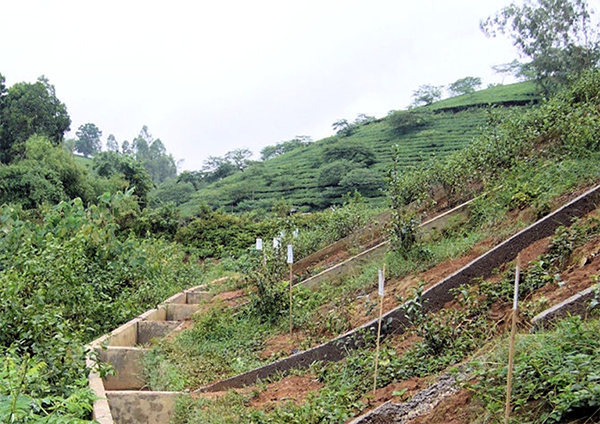 Research site in the mountains of Vietnam
Farmers in the mountains of Vietnam can plant maize crops more than two weeks early by using paraquat in a conservation tillage system. Timely operations are essential in growing all crops and paraquat’s unprecedented speed of action is often a huge help to farmers up against the weather or looking for earlier harvests to get the best prices.
Research site in the mountains of Vietnam
Farmers in the mountains of Vietnam can plant maize crops more than two weeks early by using paraquat in a conservation tillage system. Timely operations are essential in growing all crops and paraquat’s unprecedented speed of action is often a huge help to farmers up against the weather or looking for earlier harvests to get the best prices.
Results of research conducted by The Northern Mountainous Agriculture and Forestry Science Institute (NOMAFSI) show that using paraquat for weed control increased maize yields by more than 50%1. Early planting was crucial to good yields – land preparation with slow acting glyphosate herbicide resulted in much lower yields.
 Figure 1. Using min-till with paraquat reduced soil erosion
As Vietnam has developed, agriculture has had to intensify to increase food production and to compensate for reductions in labor availability due to the movement of people to cities. Much of the agricultural land in Vietnam is on steep slopes. High rainfall means that the potential for soil erosion is very high. Soil has been recorded as being lost at rates approaching 200 tonnes per hectare in a single year2. Bare soil without any plant cover is most susceptible. Pressure to grow more food has resulted in excessive soil cultivation which soon damages soil structure by reducing levels of organic matter. Poor soil structure leads to erosion and low fertility. Degraded soils mean poor harvests.
Figure 1. Using min-till with paraquat reduced soil erosion
As Vietnam has developed, agriculture has had to intensify to increase food production and to compensate for reductions in labor availability due to the movement of people to cities. Much of the agricultural land in Vietnam is on steep slopes. High rainfall means that the potential for soil erosion is very high. Soil has been recorded as being lost at rates approaching 200 tonnes per hectare in a single year2. Bare soil without any plant cover is most susceptible. Pressure to grow more food has resulted in excessive soil cultivation which soon damages soil structure by reducing levels of organic matter. Poor soil structure leads to erosion and low fertility. Degraded soils mean poor harvests.
The encouraging results of work in maize and tea have been published in the Journal of Vietnamese Agricultural Science and Technology1. NOMAFSI researchers constructed trial plots with concrete bunds to enable the amount of eroded soil to be collected and measured (Fig. 1.).
 Figure 2. Using min-till with paraquat increased maize yield
The system using paraquat resulted in much less soil erosion and much higher yields of maize - statistically better than both the usual farmer plow-based system and the min-till system using glyphosate (Fig. 2). Paraquat has the big advantage of fast action which allowed maize crops to be planted after only two days while planting was delayed by 10 and 15 days for the glyphosate and traditional systems, respectively. Also, unlike glyphosate, paraquat is not systemic so only destroys weed shoots, allowing slow regeneration of many species to provide a non-competitive ground cover. Bare soil should be avoided to resist the erosive force of rainfall and living root systems give soils structure and stability.
Figure 2. Using min-till with paraquat increased maize yield
The system using paraquat resulted in much less soil erosion and much higher yields of maize - statistically better than both the usual farmer plow-based system and the min-till system using glyphosate (Fig. 2). Paraquat has the big advantage of fast action which allowed maize crops to be planted after only two days while planting was delayed by 10 and 15 days for the glyphosate and traditional systems, respectively. Also, unlike glyphosate, paraquat is not systemic so only destroys weed shoots, allowing slow regeneration of many species to provide a non-competitive ground cover. Bare soil should be avoided to resist the erosive force of rainfall and living root systems give soils structure and stability.
Reducing cultivations during land preparation meant that considerably less labor was needed for the maize crop, as shown in the table below. As labor is the major input to crop production this reduced overall costs and boosted profits. Paraquat was especially effective because of the earlier sowing date achieved.
| Labor (man days/ha) |
Production Costs (million VND/ha) |
Profit (Loss) (million VND/ha) |
|
|---|---|---|---|
|
Traditional practice |
220 |
15.4 |
(3.0) |
| Glyphosate | 150 |
13.0 |
0.8 |
| Paraquat | 140 |
12.8 |
6.6 |
NB Labor costs = VND 40,000/day, maize price VND 5,000/kg
VND = Vietnam Dong. US$1 = VND 18,880 in April 2010
Benefits from conservation tillage and paraquat were also seen in tea. This system halved labor requirements and resulted in an extra VND 3 million profit per hectare.
In summary, NOMAFSI have found that conservation tillage systems using paraquat:
- Advance sowing date
- Reduce soil erosion
- Increase yield
- Reduce labor requirements
- Increase profitability
References
- Nguyen Quang Tin, Trinh Duy Nam, Ha Dinh Tuan and Dao Xuan Cuong (2008). The role of Gramoxone 20SL herbicide in sustainable sloping land cultivation. Journal of Vietnamese Agricultural Science and Technology, 4, 83 – 91
- Mai Van Trinh (2007). Soil erosion and nitrogen leaching in northern Vietnam. University of Wagenigen, Netherlands.

